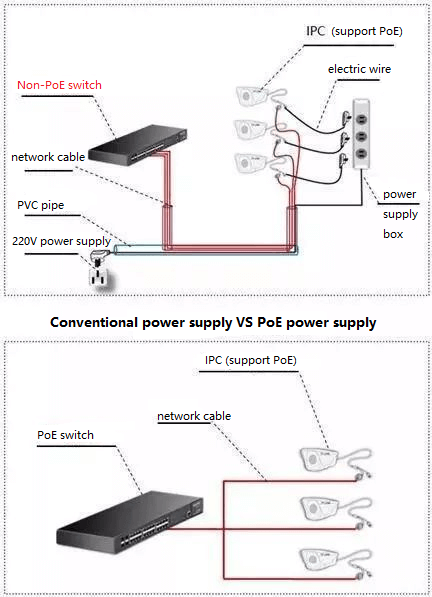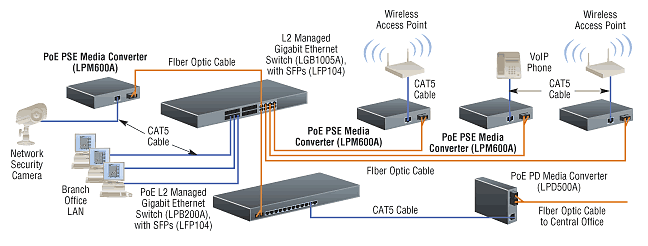PoE Transmission Distance
The typical transmission distance for PoE is up to 100 meters using standard Ethernet cables. However, many PoE switches can extend this distance to 250 meters or more under certain conditions. This extended distance is often achieved through advanced PoE technologies and enhanced cable quality that ensure efficient power and data transmission over longer distances.

Definition of PoE Switch
PoE stands for Power over Ethernet and refers to the technology that allows network cables to carry electrical power. This means that devices like IP phones, wireless access points (APs), and network cameras can receive both data and power over a single Cat.5 (or higher) Ethernet cable without the need for additional power cords or outlets.
Advantages of PoE Switches
- Cost and Time Savings: PoE switches eliminate the need for expensive power supplies and installation, significantly reducing overall costs and installation time.
- Simplified Wiring: By transmitting both data and power through one cable, PoE reduces the complexity of wiring and provides a cleaner setup.
- Flexibility: Allows for the placement of devices in locations where providing power is difficult or expensive, such as IP cameras on ceilings or outdoor access points.
Common PoE Standards
IEEE 802.3af (Standard PoE)
- Maximum Power Output: 15.4W
- PD Receiving Power: 12.95W
- Suitable For: VoIP phones, simple access points, and static IP cameras.
IEEE 802.3at (PoE+)
- Maximum Power Output: 30W
- PD Receiving Power: 25.5W
- Suitable For: HD cameras, 802.11ac access points, and PTZ cameras.
PoE Switch Power Calculation
When deploying PoE switches, it’s important to consider the power requirements of all connected devices. For example, if deploying 48 VoIP phones each requiring 12.95W, the total power budget for a 48-port PoE switch should be at least 622W (12.95W x 48). For higher power devices supported by PoE+, the calculation needs to adjust accordingly.
Extended Transmission
The claim that certain PoE switches can use cables up to 250 meters often involves:
- Enhanced PoE Technologies: Some PoE switches employ advanced technologies to boost the effective transmission distance.
- Quality Cables: Higher-quality Ethernet cables can help maintain signal integrity over longer distances.
Always ensure that the network design accommodates the power needs of the connected devices and adheres to the recommended standards for safety and performance.
Understanding these aspects will help you make informed decisions about implementing PoE in your network infrastructure, ensuring efficient, cost-effective, and reliable power and data transmission.
PoE Switch Transmission and Power Supply Distance
Standard PoE Switch Transmission Distance
As is widely known, the Ethernet standard specifies a maximum transmission distance of 100 meters. Exceeding this distance can lead to data delay and packet loss due to mutual interference between signals in twisted pairs and external electromagnetic interference. Additionally, parasitic capacitance and inductance between conductors cause signal attenuation and distortion, with the accumulated signal loss over long distances making stable signal transmission impossible.
However, not all Ethernet cables are strictly limited to 100 meters. In practice, high-quality cables can achieve effective transmission beyond 100 meters, potentially reaching around 120 meters with oxygen-free copper Cat.5 cables or Cat.6 cables. These cables can effectively reduce self-interference and avoid external interference, thus enabling longer transmission distances. Essentially, the power transmission distance in PoE depends on the cable quality. Purely in terms of power signal transmission, distances can exceed 100 meters, even reaching up to 200 meters.
Cat.5 cables are the most common types of Ethernet cables on the market today, but their quality varies significantly. Many manufacturers reduce costs by using impure copper, copper-clad iron, or copper-clad steel, leading to decreased transmission distances. High-quality cables are essential to maximize PoE efficiency. Currently, many PoE manufacturers offer switches that can support power delivery over 150 meters, 250 meters, or even 500 meters. Despite the standard PoE switch transmission distance of 100 meters, it is recommended to keep the distance within 80 meters for optimal performance.

Requirements for 150-meter Transmission Distance in PoE Switches
As mentioned earlier, the power supply distance in PoE is determined by the data signal transmission distance. Pure power can be transmitted over long distances, but data signal transmission depends on the cable quality. The typical data signal transmission distance for standard Cat.5 cables is around 100 meters. In practice, to ensure construction quality, the distance is usually kept between 80-90 meters, especially at maximum data rates like 100 Mbps.
Many manufacturers claim that their PoE switches can reach transmission distances of up to 150 meters. However, in actual applications, achieving 150-meter transmission with standard PoE switches requires high-quality cables, typically Cat.6 or higher, which increases costs.
Even with high-quality cables, if the PoE switch uses standard network switch chips and PoE power management chips, achieving 100 Mbps over 150 meters is nearly impossible. Attempting this can lead to increased power consumption, exceeding PoE power limits, and resulting in severe instability, packet loss, and significant signal attenuation. This ultimately causes network instability, accelerated aging of PoE switch devices, and increased maintenance difficulties.
Transmission Distance of PoE Switches
Achieving 250-Meter Transmission Distance
While high-performance PoE switches typically maintain stable 100Mbps transmission up to 150 meters, achieving 250 meters is possible by reducing the bandwidth to 10Mbps. This reduced bandwidth allows for extended transmission distances (up to 250 meters, depending on cable quality), but it significantly compromises high-bandwidth applications such as HD video streaming, which require higher bandwidth for smooth performance. Many manufacturers do not disclose this bandwidth reduction, potentially misleading customers.
To address this, some PoE switches include a switch to toggle between high bandwidth for shorter distances and lower bandwidth for extended distances. However, not all PoE switches achieve stable 250-meter transmission simply by reducing bandwidth; the switch’s internal components, such as network chips and power management capabilities, play a crucial role.
Ensuring 250-Meter Stable Transmission with PoE Switches
1. PoE Power Management
For 250-meter transmission, PoE switches are designed with high-power capabilities, utilizing high-quality industrial-grade power chips and intelligent power management modules. These modules automatically detect and adjust power output according to IEEE802.3af/at standards using 8-wire intelligent power technology. Built-in power supplies enhance performance by optimizing specific designs and automatically adjusting voltage input to match the power needs of connected devices.
Additionally, extended cable distances increase the likelihood of cable damage, so PoE switches are equipped with overcurrent and overvoltage protection circuits. PoE standards ensure non-PoE devices only transmit data without drawing power, maintaining stability and preventing damage.
2. Network Transmission
Achieving 250-meter transmission with standard switches requires strict adherence to cable quality. Lower-quality cables significantly reduce transmission distances. In practice, it is recommended to keep PoE transmission within 100 meters for standard applications and use high-quality cables to extend the range to 120 meters when necessary.
